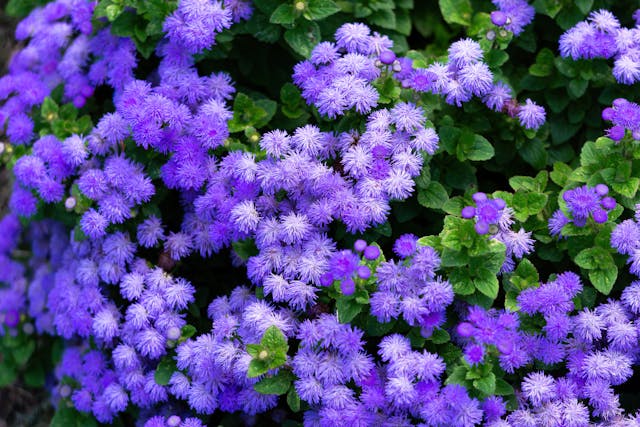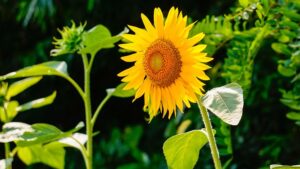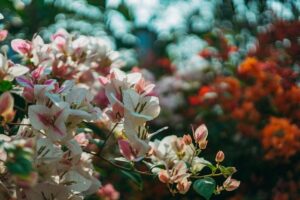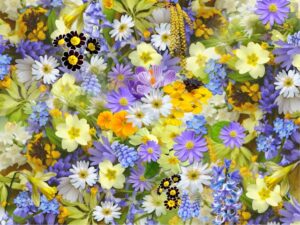Known for its classic appearance, ageratum is an excellent annual for cutting gardens. Its fun, little blossoms, which resemble tiny pom-poms wrapped in filaments that resemble floss, have earned it the nickname “floss flower.” It also provides blue, which is uncommon in the flower world and ideal for growing patriotic arrangements. Additionally, ageratum comes in a variety of pink, purple, and white hues.
Pollinators love these blossoms regardless of their hue. Visiting these plants and sipping their delicious nectar is a delight for butterflies. Late spring is when the plants start to blossom, and they continue to do so until the first frost. These hardy plants are not favored by deer and may survive in poor soil conditions.

Where to Plant Ageratum
Ageratum may be planted anywhere that receives full sun for at least part of the day and has rich, well-draining soil with an acidic pH of 5.0 to 6.0. A spot that receives partial shade and protection from the afternoon heat is suitable if you live somewhere with scorching summers. In more northern climates, ageratum should be planted in full sun.
The pompom-shaped blooms stand out in hanging baskets, mixed containers with other plants, flower beds, borders, and rock gardens. Their blue hue looks even more striking when grouped together, but they also make excellent companion plants for annuals that have matching hues, like salvia.
When and How to Grow Ageratum
After the final date of frost, plant ageratum. It is best to harden off the young plants before putting them outdoors.
You don’t need to dig a hole that is much deeper than the container the seedling came in since ageratum roots are shallow. Put them nine to twelve inches apart. Planting plants too closely together may promote the spread of illness and result in poor air circulation.
Care Instructions for Ageratum
Light Ageratum may be grown in either full sun or partial shade, but be aware that reduced light exposure may result in fewer blooms and a less compact and leggier plant.
Water and Soil
Planting ageratum requires rich soil that has adequate drainage. Till the plants get established, give them frequent irrigation. You will need to water the plants if it doesn’t rain since they need roughly one inch of water every week. Watering container plants should be done more frequently—daily in hot summer months.
Humidity and Temperature

Warm-season annuals, ageratums are harmed by the cold. They are easily destroyed by a cold period if they are planted too early in the spring. On the other hand, you may cover the plants to prolong their lives if you get early summer frosts.
Apply fertilizer
Because of their long bloom, ageratums are heavy feeders. During the growth season, treat in-ground or potted plants once a month using a general-purpose fertilizer. Usually, you can tell when the plants need more food because when they don’t have enough nutrition, their leaves quickly turn yellow.
Trimming
Deadheading wasted flowers is not necessary with ageratums since they develop so quickly and are so floriferous. The fact that the plant will outgrow them rapidly contributes to its reputation as a low-maintenance annual.
Ageratum: Planting and Repotting
Because of their small size, the plants are also great container plants. Plant them in well-draining soil and fertilize them with a slow-release product.
Problems and Pests
Plants that are cultivated in shaded areas may be more susceptible to foliar diseases like powdery mildew. The prevalence of powdery mildew is highest in humid, rainy weather. Fortunately, your plants won’t perish from this; it’s just ugly. Maintaining appropriate air circulation and keeping plants dry at the base is the best course of action.
Methods for Spreading Ageratum
These hardy small plants may be grown from seed, but in the spring, garden stores offer them in multipacks. Four to six weeks prior to the first day without frost, start them inside. Since the seeds need sunshine to germinate, avoid covering them with dirt. Plant them outdoors as soon as the latest frost date has gone.
Ageratum Types: Artist Purple Ageratum
These tiny, heat-tolerant mounding plants are covered in rich purple blossoms.
Ageratum “Blue Danube”
Ageratum ‘Blue Danube’ is just 8 inches tall and has lavender-blue blooms.
Ageratum ‘Hawaii White’
Ageratum ‘Hawaii White’ bears white blooms and reaches a height of 6 to 8 inches.
Sage, Salvia, and Ageratum Companion Plants
Seldom can one find a garden without at least one salvia plant. There’s an annual salvia that you’ll find important, regardless matter whether your garden is dry, sunny, or receives loads of water. All are excellent choices for hot, dry settings where you want plenty of color throughout the season and attract hummingbirds, particularly the red ones. Plant salvias outside after all chance of frost has gone, since most of them dislike chilly weather.

French Marigold
The elegant marigolds, as you could expect from something named French. French marigolds have frilly petals, and some have a characteristic “crested eye.” Their trendy, tidy, small growth habit and attractive dark green leaves allow them to reach a height of around 8 to 12 inches. They will bloom all summer long and thrive in full light and wet, well-drained soil. They could proliferate, coming back year after year to areas where they feel content.
Every year Vinca
Annual vinca is a must-have—it really delivers. It can withstand a great deal of weather and yet produce glossy green, almost unreal-looking blossoms as well as lovely pink, lavender, or crimson flowers that resemble small parasols. Vinca plugs along undisturbed by hot or cold, dry or rainy summers. It looks beautiful in a container, but for maximum impact, arrange at least eight or more of them together when planting in a bed or border. Establish seedlings and plant them in the spring when the risk of frost has gone. Vinca thrives in moderately damp conditions but may tolerate droughts. Periodically fertilize. This plant, like impatiens, is usually “self-cleaning” and requires minimal deadheading.



